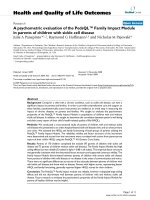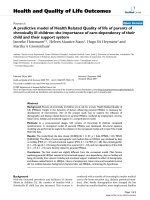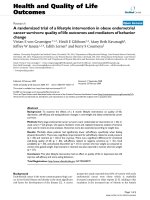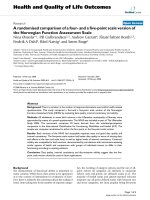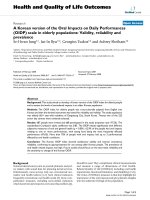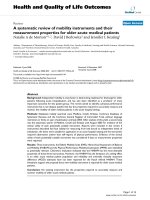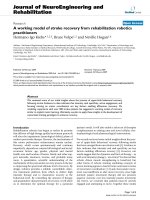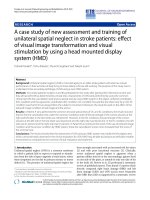Báo cáo hóa học: " A modeling assessment of geneflow in smallholder agriculture in West Africa" ppt
Bạn đang xem bản rút gọn của tài liệu. Xem và tải ngay bản đầy đủ của tài liệu tại đây (375.9 KB, 10 trang )
RESEARCH Open Access
A modeling assessment of geneflow in
smallholder agriculture in West Africa
Denis Worlanyo Aheto
1*
, Hauke Reuter
2
, Broder Breckling
3
Abstract
Purpose: Small-scale agriculture is an important issue for food security in Africa. In the context of Genetically
Modified Organisms, approaches to quantify geneflow in small-scale systems are widely unexplored. We aimed at
bridging this gap by contributing to the scientific discussion on the un certainties of the cultivation of genetically
modified (GM) crops in the region. The safety issue is: Would it be possible to withdraw a variety in case that
unexpected and undesirable effects occur? e.g. the resistance of pests which make the variety no more useful.
Methods: We used a GIS approach to determine the location of maize cultivation sites, field geometries and
applied a model for the calculation of geneflow scenarios.
Results: The data revealed that the given cropping density provides optimal conditions for transgene spread,
potentially limiting the possibility for coexistence between GM and non-GM fields. On average, we found about 60
fields within a nearest distance of 100 m, and cropping density of 56 fields per square kilometer. The resulting
cross-pollination rate from the single GM field into the neighbouring conventional fields was estimated to be
about 0.12%.
Conclusions: GM varieties if introduced could remain in cultivation even if their admission has expired or has
been retracted. This would be undesirable and could cause long-term, undesirable stacked combination of
transgenes which cannot be tested with respect to eventual combinatory effects. These developments pose major
challenges for fielder livelihoods, and conservation of maize genetic resources with potentially negativ e
consequences for the African food export sector.
Purpose
In spite of an obvious need, few studies exist focusing
on biosafety research in Africa. This paper therefore
presents an accou nt of a project that assessed the impli-
cations of Genetically Modified Organisms (GMOs) in
small-scale agricultural systems in Africa by focusing on
a specific sector of agricultural food production in
Ghana. Maize cultivation has been used in this instance
to distinguish the differ ences that exist between agricul-
ture in the USA or Europe, and elsewhere in other
developed countries and thos e of the African conditions;
in particular, looking at the agricultural structure, crop
field locations, isolation distances between cultivated
fields and spatial patterns of agricultural fields which are
completely heterogeneous. On the basis of a modelling
approach, representative scenarios are calculated to
address the possible impacts of gene flow between
genetically modified (GM) and conventional fiel ds due
to cross-pollination.
We use the situa tion of agricultural maize production
in Ghana to typify the situation of subsistence-based
fielding context in West Africa which is the predomi-
nant mode of fielding as o pposed to a very minor pro-
portion that occur as large-scale commercial fielding
enterprises. Agricultural land area in Ghana estimates to
about 58.3% of total land area of 24 million hectares.
Individual field sizes measure b etween 1 and 2 ha [1].
Within these land holdings, maize represents the major
food crop cultivated, since it constitutes the major food
staple for a majority of the po pulation [2]. Maize is
often grown in association with other crops. However,
the demand for maize in particular as a major food
source in the country has led to the observed annual
increase in acreage of land grown to maize (Figure 1)
* Correspondence:
1
School of Biological Sciences, Science Faculty Building, University Pos t
office, University of Cape Coast, Ghana.
Full list of author information is available at the end of the article
Aheto et al. Environmental Sciences Europe 2011, 23:9
/>© 2011 Aheto et al; licensee Springer. This is an Open Access article distributed under the terms of the Creative Commons Attribution
License ( wh ich permits unrestricted use, distribution , and reproduction in any medium,
provided the original work is prop erly cited.
[3,4]. Therefore, acreage of land sown to maize has stea-
dily increased into the overall agricultural land area.
Field surveys have revealed that fielders mostly sow frac-
tions of grains bought for food, or seeds saved from pre-
vious harvests, obtained as gifts from other fielders,
exchanged or simply procured through the formal seed
system mainly from seed shops [5]. In the context of
land use, the increasing intensity of maize cultivation
coupled with the comple xities of seed use and exchang e
has m ade the discussion on GMOs highly contentious.
The situation is largely constrained because regional
markets for GMOs are being developed in Africa. Profits
and progress are promised in view of a new wave of
growth for the agricultural sector in the region [6]. In
this regard, GMOs are advertised as an option in sup-
port of poverty and hunger alleviation and to feed poor
countries i n the region [6-8]. Alongside these develop-
ments, serious concerns exist relating to the long-term
economic benefits of the technology to small fielders.
Questions are being asked about who benefits and who
appropriates? Consequently, African states would be in
thepositiontoinvesthugeexpenditurestoredress
environmental damages on the numerous and spatially
disaggregated small fields if negatively impacted upon
and the resulting public health consequences if adverse
effects e merge [9]. For example, setting up huge GMO
testing facilities at ports of entry comes at additional
costs to government that must be well taken into
account in advance.
There are also concerns about the unclear nature of
the use of genetic resources in the advent of GMO and
related issues of patenting and biopiracy since small
traditional fielders would like to benefit from their many
years of sustaining s eed biodiversity maintained over
centuries [5]. There is the fear of a high possibility of
transgene escape if grain is used as seed, assumed likely
under the present agricultural circumstances given the
traditional seed exchange and utilization culture [10].
These issues are discussed as legitimate concerns in this
context since maize is widely used as food in Africa,
with the crop representing the largest component of
food for the greater segment of the African population.
It i s also noteworthy that elsewhere in the world, the
deployment o f GM maize has practically caused wide-
spread environmental, economic and legal problems
[11]. For example, there have been events of genetic
contamination by transgenes in managed non-transgenic
conventional production fields in Mexico [12]. Again,
GM pollen with insect resistance may pose potential
hazard to non-target insect species as has been reported
by several authors [13-15]. As far as regulation is con-
cer ned, it has been argued that though various acts and
regulations a re in place in some African countries and
are su pposed to be implemented, there is no formal sys -
tem to verify the GM content of trans-boundary con-
signments, save for the permission of permits. The
regulation of mandatory labelling of GMOs is inactive
and there is no provisio n for GMO labelling in terms of
consumer preference [16].
Owing to the aforementioned complexities of seed use
or exchange practices, agricultural structure, increasing
land use and maize cultivation intensity, weak regulatory
and enforcement capacity in A frican countries, the safety
issues refer to whether it would be feasible to recall a GM
variety in case the unexpected happens. For example, with
an occurrence of undesirable effects such as the resistance
of pests which make the variety no longer useful.
In order to contribute to the scientific discussion, our
study sought to calculate geneflow assessment of cross-
pollination rates under various scenario assumptions of
maize cultivation, and calculate field neighbourhood dis-
tance relations and estimate general field geometries.
These parameters have been intended to contribute to
improvements for biosafety assessment at the local level
and support the institution of precautionary measures
according to the Cartagena Protocol on Biosafety [17]
referring to Art. 1, 10, 11 and Annex III) that enjoins
sovereign states or governments to take precaution and
extended to cover other contextual issues including
aspects of receiving environments and not only on the
basis of existing knowledge. The specific objectives of
the study were to:
1. Use geographic information system (G IS) to
characterize crop fields to assess their distribution
and isolation distances.
y = 13.98x - 27244
R
2
= 0.8011
0
100
200
300
400
500
600
700
800
900
1000
1965 1970 1975 1980 1985 1990 1995 2000 2005
year
Area (000 ha)
Figure 1 Maize production in Ghana (1965-2005) showing area
of land grown to maize over the period. Source: Calculated from
FAO database (2007); and Morris et al. (1999) Adoption and Impacts
of Improved Maize Production Technology: A Case Study of the
Ghana Development. Project. Mexico, D.F.: CIMMYT.
Aheto et al. Environmental Sciences Europe 2011, 23:9
/>Page 2 of 10
2. Conduct frequency and cropping density analysis
to assess feasibility of coexistence measures.
3. Simulate regional cross-pollination to determine
potential for geneflow in smallholder systems follow-
ing a modeling approach.
We hypothesize t hat smaller cultivated fields and
higher heterogeneity of the seed sources implicitly lead
to an increased geneflow and increased genetic exchange
in the longer term. This is a preliminary study in which
minimal baseline scenarios have been used relevant for
biosafety assessment for African agriculture taking into
account an African environmental perspective.
Methods
The study was carried out within a peri-urban district of
Accra, the capital city of the Republic of Ghana. The
methods used had been adapted to the Ghanaian agri-
cultural and environmental conditions based on other
works [18]. Data on spatial orientation of crop fields
(see Table 1) in a 25-km
2
region were determined using
a global positioning system (GPS) receiver, and later
systematized through a GIS database using ArcGIS.
Cross-pollination was not measured directly but poten-
tial gene flow was assessed by applying a model-based
analysis process. Analysis of cross-pollination s tudies
[19-28] and the subsequent development of a dispersal
kernel had been done (Figure 2) [29] describing cross-
pollination relative to source-sink-distance and field-
size. This dispersal-kernel was applied in simulations to
calculate cross-pollination between maize fields. As the
model uses simplified geometric structures, it may be
applied for whole regions. The model was developed lar-
gely for European conditions within the GeneRisk Pro-
ject funded in the context of the Social Ecology Call in
2008 ( />692.php). The relevant data to parameterise the model
for t he Ghanaian conditions include field maps, variabil-
ity in the sowing dates, the vegetative period, duration
of pollination and maximum distance of dispersal. Isola-
tion distances from field neighbours were calculated
using computer programs written i n SIMULA [30].
Five (5) scenarios were assessed, implying that genetic
modifications (GM) or transgenes get introduced through
mode of seed acquisition and via larger fields as follows:
― Scenario 1: GM seeds sown were obtained under
exchange conditions, meaning that the seeds were
obtained from other fielders as gifts or exchanged.
― Scenario II: GM seeds sown were obtained from
the seed market. This directly implies the use of
commercial GM varieties.
― Scenario III: A single GM field introduced at the
center of the study area. This sugges ts the scenario
of a single GM field among 1,388 conventional
fields.
― S cenario IV: GM se eds sown were obtained from
seeds saved from previous harvests.
― Scenarion V: GM seeds sown were obtained from
food market. This scenario implies that variety planted
was collected from quantities bought for food.
The model was run 10 times per scenario and average
calculations written to an output file (see Table 4).
Results
1. Cropping density and field geometry
Table 2 provides an overview of the cultivation context
as obtained from GIS records for the area of 25 km
2
in
peri-urban Accra.
Table 1 Ground surface data based on GPS measurements
Sample
number
Variable Descriptors Assignments
1 Field
locations
Specification of single locations of field allotments based on GPS
readings of first point of entry of the cultivation area referred
herein as field.
For estimating minimum distance between fields. This
is an important parameter for estimating the
probability of gene (pollen) transfer from genetically
modified to conventional maize fields (or vice versa).
This is also useful to estimate the length of field
borders.
2 Field sizes Estimation of total acreage of fields - measurements taken at
corners of the cultivation area ranging from 3-22 corners,
depending on field extent.
Mean field size gives information on the dispersal
characteristics of the cultivation area.
The spreading of pollen is more likely in regions with
large number of smaller fields than in regions with
fewer larger fields.
3 Feral/
volunteer
locations
Specification of precise location points within same habitat patch. For estimation of nearest neighbour relations.
Assesses the probability of cross-pollination between
fields and feral locations
Aheto et al. Environmental Sciences Europe 2011, 23:9
/>Page 3 of 10
(b)
(a)
Figure 2 Analyzed cross-pollination studies. Literature studies on distance-related out-crossing rates in hybrid maize fields (a) used for the
development of the dispersal kernel (b), projected on a double logarithmic scale. The data shows a regression function with a gradual reduction
in hybridization rates from 0.14% at 100 m, 0.1% at 200 m, and 0.06% at 250 m and about 0.01% at over 1,000 m. The displayed references in (a)
are quoted in the reference list. The data of Ortega Molina (2003a) and (2003b) were republished in 2004.
Aheto et al. Environmental Sciences Europe 2011, 23:9
/>Page 4 of 10
For an urban settlement area, a 4.5% fractional area
grown to maize is significant. The incorporation of GM
varieties could impact highly on the agrifood sector of
traditional maize cultivation. In Figure 3, about 98% of
all field locations occur within distance of 5-150 m
from the next neighbour. Shortest nearest distance from
next neighbour recorded occurred within 5 m. Longest
nearest distance occurred at a distance of 459 m.
Table 3 shows that there are up to a maximum of
three field neighbours on average within a distance of
20 m, and up to a total maximum of seven field neigh-
bours within a distance of 40 m. A maximum of 38 field
neighbours occur within a 120 m distance.
Figure 4 shows that even though fields are very small
in size (mostly approximately <2 ha), considerably large
areas are grown to maize. Fields cultivated in the region
occur irregularly and widespread on the landscape.
There are indications of bounda ry segments of only
about 1 m occurring between some adjacent fields. It
appears therefore that the small-scale fields do not fol-
low a purely managed cultivation pattern. The data
explains that neighbouring fields could have high crop
population and cross-pollination interaction rates. Many
small fields occur in the vicinity of a larger field, sug-
gesting potentially highe r cross-pollination from larger
fields to neighbouring smaller fields.
Figure 5 provides indication of high cropping densities
involving many small fields, randomly distributed over
the landscape. The data shows that the cultivation of
fields is highly irregular, and often occurring in associa-
tion with one another.
2. Simulations of regional cross-pollination
The simulation was primarily based on GPS-derived maps
indicating locations of crop fields where fielders planted
seeds acquired on exchanges from other fielders and con-
trasted with those locations where fielders planted seeds
bought from the seed market. Model calculations a re
further analyzed for additional scenarios executed for
different potential situations tha t could occur (Table 4).
Table 2 Cropping density factors of maize fields in the
study area
Item Description
Cropping density (number of fields km
-2
) 56.0
Total maize area calculated from GIS records (km
2
) 1.1
Fractional area of maize as a % of total study area 4.5
% Field sizes below 0.5 ha 97.4
% Field sizes between 0.5-1 ha 1.6
% Field sizes between 1-2 ha 0.8
% Field sizes above 2 ha 0.2
Total number of fields was 1,390.
0
20
40
60
80
100
120
140
5
35
65
95
125
155
185
215
245
275
305
335
365
395
425
455
485
515
545
575
Distance between cultivated plots (m)
Frequency
Figure 3 Nearest neighbour distance analysis of crop fields.
Table 3 Cropping isolation distances of field neighbours
Number of field neighbours within distance ranges
Distances (m) Mean (maximum number of fields)
0-20 0.2 (3.0)
20-40 0.6 (4.0)
40-60 0.8 (5.0)
60-80 1.0 (7.0)
80-100 1.1 (8.0)
100-120 1.4 (11.0)
Aheto et al. Environmental Sciences Europe 2011, 23:9
/>Page 5 of 10
Table 4 Assessment of potential impacts of geneflow based on various seed sources using the MaMo
Maize hybrids
Modelling Scenarios Average GM
content in
conventional seed
harvest
GM fields created as a
percentage of total number of
fields (including conventional
fields)
GM field area estimated as a
percentage of total field area
(including conventional fields)
Scenario I: GM planted was obtained under
exchange conditions, meaning that the seeds were
obtained from other fielders as gifts or exchanged.
0.87 3.02 2.27
Scenario II: GM planted were obtained the seed
market. This directly implies the use of commercial
varieties.
2.61 7.70 6.02
Scenario III: GM planted was obtained from seeds
saved from previous harvests.
1.00 4.24 2.40
Scenario IV: Single GM field introduced at the center
of the study area. This suggests the scenario of a
single GM field among 1,388 fields
0.12 0.07 0.21
Scenario V: GM planted obtained from food market.
This scenario implies that variety planted was
collected from quantities bought for food.
1.12 2.52 3.78
The single GM field scenario in conventional fields was introduced as a hypothetical issue.
Figure 4 Field geometries and distribution of maize fields displayed on a 2 × 2 km
2
grids.
Aheto et al. Environmental Sciences Europe 2011, 23:9
/>Page 6 of 10
This allows to estimate the effects resulting from not only
for single GM central fields but also to consider the effects
of random processes, how the entry of GM seeds obtained
from food and seed markets or eventually from previous
harvests could influence cross-pollination in conventional
fields. The specification of field locations on maps for seed
sources and type of seed cultivated was obtained through
a questionnaire.
The model provides average cross-pollination rates
basing on several world-wide studies capturing the
variability in climate and environmental fac tors. A map
was derived for all locations where seeds had been
planted from: (a) exchange sources, (b) seed market and
(c) and those obtained from previous harvests. The sin-
gle GM central field (d) had been assumed in order to
derive hypothetical scenario for the possible impacts of
a single GM field, and (e) assuming that GM seeds
planted were obtained from food market. This scenario
implies t hat variety planted was collected from quanti-
ties bought for food (see Table 4).
Figure 5 Cropping geometry and density analysis of smallholder maize a gricultural systems. The maps provide examples of a higher
number of smaller fields occurring in close association with larger fields suggesting higher probabilities of gene flow from larger fields to
smaller fields. In addition, high cropping density regions suggest the growing of different maize seed varieties with indications of seed exchange
and admixture among fielders. The entire region investigated is shown on the right hand maps.
Aheto et al. Environmental Sciences Europe 2011, 23:9
/>Page 7 of 10
3. Model Scenario 4: single GM field in the centre of the
study area
Modeling simulation with a single GM field located in
the centre of the investigated region (circled). Each of
the fields serves as a pollen source and calculates the
impact to all other fields. It shows the involvement of
random processes depending on size and location of
fields as well as sowing time.
The resulting model data suggest that smaller fields
provide conditions for enhancing transgene spread due
to their very small nature and close proximity with each
other (Figure 6) and geneflow between GM and conven-
tional fields is generally high regardless the source of
seed used or seed acquisition scenario (Table 4). Analysis
from the model further shows that a conventional field at
a distance and size of 300 m (200 m
2
), 800 m (4,000 m
2
)
and 1500 m (10,000 m
2
)fromasinglecentralGMfield
would have average cross-pollination rates of 4.5%, 1.0%
and 0.5% respectively (Figure 7). This strongly suggests
that cross pollination rates in conventional fields gener-
ally decreases with increase in field size and distance to
the GM field and vice-versa.
Conclusions
1. Agro-structure and coexistence considerations
The data show that the use of isolation distances between
GM and conventional fields as a management measure or
requirement to minimize or control gene flow is chal-
lenged in the given conditions. Most fields are small, with
about 97% of fields below 0.5 ha (Table 2), occurring in
very close proximity (Figure 3). For example, on a scale of
100 m, a maximum of three, four, five, seven and eight
field neighbours would have to be expected at distances of
20, 40, 60, 80 and 100 m, respectively (Table 3). With a
minimum nearest neighbour distance of 5 m and a maxi-
mum nearest distance of 459 m (Figure 3), the practice of
co-existence of GM and conventional cropping would not
be possible. In an event of GM introduction, on-field con-
servation of maize genetic resources is unlikely due to
potentially higher cross-pollination in smaller fields (Fig-
ure 5). These findings coincide with studies conducted in
Brazil [31] e.g. setting of a minimal isolation distance for
coexistence for maize fields would be impractical. Hence,
the usefulness of isolation distances under the given condi-
tions is challenged. We conclude therefore that the
hypothesis that for smaller cultivated fields and higher het-
erogeneity of the seed sources implicitly lead to increased
geneflow and increased genetic exchange holds true.
2. Cross-pollination scenarios and implications for
gene flow
The size of a recipient field, its location and the distance to
a GM field are important parameters to estimate the prob-
ability of transgene i ntrogression. For example, a single
GM field was used as a m inimum scenario (Figure 6). It
turned out that a single GM field comprising 0.2% of the
area could lead to gene flow in the considered region up
to 0.12% of GM in the conventional harvest. There are
indications that small fractions of transgene introgression
in the order of magnitude from 0.12-2.61% into conven-
tional fields are possible under the various tested condi-
tions (Table 3). If the EU regulat ions would apply for the
Figure 6 Model simulation of a single GM central field among
over 1,300 conventional fields. (a) Shows the initial map with
centre field (circled) (b) Shows the results of cross-pollination rates
of the fields. There are some conventional fields that do not receive
any GM input even though they occur in close association with the
GM field, due to the effect of different sowing dates, and the fact
that pollination times do not overlap. Random processes involved in
pollen movement are incorporated in the model.
Aheto et al. Environmental Sciences Europe 2011, 23:9
/>Page 8 of 10
African conditions at the same labeling threshold of 0.9%,
any increasing condition of transgene presence in conven-
tional harvests from any magnitude above 0.9% is suffi-
cient to be labeled and sold as GM. On-field conservation
would be unlikely in an event of GM cultivation within
small-scale agriculture due to increasing content of GM
traits in field-saved seeds. Potentially, this would have
severe consequences for the African food export sector
and further deepen existing trade barriers afflicting the
continent. For the reasons stated above, we recommend:
- the efficient regulation of maize grains used as
food or feed products or even for seed imported into
thecountrysinceitishighlyunlikelytocontrol
transgene spread in the environment should they be
later found out to be genetically modified varieties;
- to consider the cost implications for small fielder
livelihoods and the additional cost to the local seed
biodiversity that must well be taken into account.
We conclude that GMO maize should not be cultivated
within the agricultural systems in Ghana and other West
African countries with comparable agricultural condi-
tions and efforts to introduce them should be curtailed.
Acknowledgements
The authors would like to thank Mr. Christian Aden formerly of the
Department of Landscape Ecology of the University of Vechta, Germany for
support with the GIS approach.
Author details
1
School of Biological Sciences, Science Faculty Building, University Pos t
office, University of Cape Coast, Ghana.
2
Leibniz Center for Tropical Marine
Ecology (ZMT), Fahrenheitstr. 6, 28359 Bremen, Germany.
3
Department for
Landscape Ecology, University of Vechta, Oldenburger Str. 97, 49377 Vechta,
Germany.
Authors’ contributions
DWA: Conceived the study, conducted field surveys in Ghana, handled data
analysis, write-up and coordination. HR: Developed the maize model that
was applied in this study in cooperation with BB and discussed the findings.
BB: Participated in the design of the study, wrote programmes in SIMULA for
handling large spatial data sets and supported data supervision and
interpretation issues.
Competing interests
The authors declare that they have no competing interests.
Received: 23 January 2011 Accepted: 25 February 2011
Published: 25 February 2011
References
1. Al-Hassan R, Jatoe JBD: Adoption and Impact of Improved Cereal Varietie
in Ghana. Paper prepared for the Workshop on the Green Revolution in Asia
and its Transferability to Africa Tokyo, Japan; 2002 [ />chosa/forum/fasidforum/ten/fasid10/dl/2-7-p.pdf], FASID 8-10 Dec. 2002
Accessed on 5 June 2007.
Figure 7 Cross-pollination rates of conventional fields. These are based on their sizes and distance to a single central GM source field. The
data indicates that cross-pollination generally increases with a decrease in field size and distance to the single GM field and vice-versa.
Aheto et al. Environmental Sciences Europe 2011, 23:9
/>Page 9 of 10
2. Fosu M, Kühne RF, Vlek PLG: Improving maize yield in the Guinea
Savannah Zone of Ghana with leguminous cover crops and PK
fertilization. Journal of Agronomy 2004, 3(2):115-121.
3. FAO: FAOSTAT. 2007 [ />PageID=336].
4. Morris LM, Tripp R, Dankyi AA: Adoption and Impacts of Improved Maize
Production Technology: A Case Study of the Ghana Devlopment Project.
Economics Programme Paper 99-01 Mexico, D.F.:CIMMYT; 1999.
5. Aheto DW: Implication Analysis for Biotechnology Regulation and
Management in Africa. Baseline studies for Assessment of Potentential
Effects of Genetically Modified Maize (Zea mays L.) Cultivation in
Ghanaian Agriculture. Theory in Ecology 2009, 15:240.
6. ISAAA (International Service for the Acquisition of Agri-Biotech
Applications): Global Status of Commercialized Biotech/GM Crops 2009.
2009 [ />7. Walters R: Crime, Bio-Agriculture and Expploitation of Hunger. British
Journal of Criminology 2005, 46(1):26-45.
8. African Center for Biosafety and Friends of the Earth Nigeria: Ten Years of
Genetically Modified Crops Fail to Deliver Benefits to Africa. 2006
[ />9. African Union Commission: Compliance and Dispute Settlement
Mechanisms for Biosafety. A publication series of the AU-German
Cooperation Project “Support for the African Union on Issues of
Biosafety”. Addis Ababa: AUC Publishing and Reproduction Plant. 2009.
10. African Union Commission: Identification and labelling of living Modified
Organisms (LMOs). A publication series of the AU-German Cooperation
Project “Support for the African Union on Issues of Biosafety”. Addis
Ababa: AUC Publishing and Reproduction Plant; 2009.
11. Hewlett K, Azeez G: The economic impacts of GM contamination
incidences on the organic sector. Proceedings of the Third International
Conference on Coexistence between Genetically Modified (GM) and non-GM
based Agricultural Supply Chains, 2007 November 20-21 Seville, Spain; 2007,
336-337.
12. Quist D, Chapela IH: Transgenic DNA introgressed into traditional maize
landraces in Oaxaca. Nature 2001, 414:541-543.
13. Aylor DE: Settling Speed of Corn (Zea mays) Pollen. Aerosol Science 2002,
33:1601-1607.
14. Losey JE, Rayor LS, Carter ME: Transgenic Pollen Harms Monarch Larvae.
Nature 1999, 399:214.
15. Andow DA, Hilbeck A: Bt Maize, Risk Assessment and the Kenya Case
Study In Environmental Risk Assessment of Genetically Modified
Organisms. In A Case Study of Bt Maize in Kenya. Volume 1. Edited by:
Hilbeck, A. Andow, D.A. Wallingford: CABI Publishing; 2004.
16. Viljoen CD: Experiences and lessons learnt in the implementation of the
identification/documentation requirements in the context of paragraph
2 of Article 18 of the Biosafety Protocol. Lessons from South Africa.
Biosafety Protocol News 2007 Secretariat to the Convention on Biological
Diversity, Montreal; 2007.
17. Cartagena Protocol on Biosafety:
Under the Convention on Biological
Diversity, CBD. 2000 [ />18. Menzel G: Verbreitungsdynamik und Auskreuzungspotenzial von Brassica
napus L. (Raps) im Großraum Bremen–Basiserhebung zum Monitoring
von Umweltwirkungen transgener Kulturpflanzen. Dissertation University
of Bremen; 2006.
19. Bannert M: Simulation of transgenic pollen dispersal by use of different
grain colour maize. Dissertation Eidgenössische Technische Hochschule Zürich
2006, Nr. 16508.
20. Della Porta G, Ederle D, Bucchini L, Prandi M, Pozzi C, Verderio A: Gene
flow between neighboring maize fields in the Po Valley: a fact-finding
investigation regarding coexistence between conventional and non-
conventional maize fielding in the region of Lombardy, Italy.Edited by:
Eder, J. Report, Centro Documentazione Agrobiotechnologie, Milan, Italy;
2006: [], (2006) Bericht zum Erprobungsanbau mit
gentechnisch verändertem Mais in Bayern 2005, Schriftenreihe der
Bayrischen Landesanstalt für Landwirtschaft, Freising Weihstephan.
21. Eder J: Bericht zum Erprobungsanbau mit gentechnisch verändertem
Mais in Bayern 2005, Schriftenreihe der Bayrischen Landesanstalt für
Landwirtschaft, Freising Weihstephan. 2006 [].
22. Fabie A: Research on coexistence in the field. French experiments for
maize. COPA COGECA Colloquy on the co-existence and thresholds of
adventitious presence on GMOs In conventional seeds. 2004.
23. Henry C, Morgan D, Weekes R, Daniels R, Boffey C: Field scale evaluations
of GM crops: monitoring gene flow from Gm crops to non-GM
equivalent crops in the vicinity (contract reference EPG 1/5/138). 2003
[ Part I:
Forage Maize. Final report, 2000/2003.
24. Jemison JM, Vayda ME Jr: Cross pollination from genetically engineered
corn: wind transport and seed source. AgBioForum 2001, 4:87-92.
25. Ma BL, Subedi KD, Reid LM: Crop ecology, management & quality. Extent
of cross-fertilization in maize by pollen from neighboring transgenic
hybrids. Crop Science Society of America 2004, 44:1273-1282.
26. Melé E: Spanish study shows that coexistence is possible. Agricultural
Biotechnology International Conference ABIC 2004, 3:2.
27. Ortega Molina J: Results of the studies into the coexistence of genetically
modified and conventional maize. COPA-COGECA colloquy on the co-
existence and thresholds of adventitious presence on GMOs in
conventional seeds. 2004 [ />28. Weber WE, Bringezu T, Broer I, Holz F, Eder J: Koexistenz von gentechnisch
verändertem und konventionellem Mais. mais - Die Fachzeitschrift für
den Maisanbauer. 2005, Sonderdruck 1+2/2005.
29. Reuter H, Böckmann S, Breckling B: Analysing cross-pollination studies in
maize. In Implications of GM-Crop Cultivation at Large Spatial Scales. Edited
by: Breckling, B, Reuter H, Verhoeven R. Frankfurt, Peter Lang; 2008:47-53,
Theorie in der Ökologie 14.
30. Pooley RJ: An introduction to programming in SIMULA, Blackwell
Scientific. Oxford; 1986.
31. Cordeiro A, Alves AC, Ogliari J: Challenges for co-existence in small-scale
fielding: the case of maize in Brazil. In Implications of GM-Crop Cultivation
at Large Spatial Scales. Edited by: Breckling, B., Reuter, H. & Verhoeven, R.
Frankfurt, Peter Lang; 2008:, (2008) Theorie in der Ökologie 14.
doi:10.1186/2190-4715-23-9
Cite this article as: Aheto et al.: A modeling assessment of geneflow in
smallholder agriculture in West Africa. Environmental Sciences Europe
2011 23:9.
Submit your manuscript to a
journal and benefi t from:
7 Convenient online submission
7 Rigorous peer review
7 Immediate publication on acceptance
7 Open access: articles freely available online
7 High visibility within the fi eld
7 Retaining the copyright to your article
Submit your next manuscript at 7 springeropen.com
Aheto et al. Environmental Sciences Europe 2011, 23:9
/>Page 10 of 10


